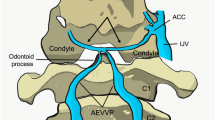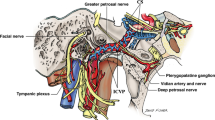Abstract
Purpose
The foramen cecum (FC) is a fine bony canal with the aperture located immediately anterior to the crista galli (CG). The venous structures in the regions of the FC and CG have been inconsistently described and are not well understood. Here we explore these veins using magnetic resonance imaging.
Materials and methods
We enrolled 101 patients who underwent contrast examinations and exhibited intact skin, skull, dura mater, and intracranial dural sinuses. Imaging data were obtained as thin-sliced, seamless sagittal sections and were transferred to a workstation for analysis.
Results
In 84 % of the patients, tubular-shaped venous extensions arose from the rostral end of the falx cerebri and were confirmed to lie in the FC. These extensions were supplied by the superior sagittal sinus or the frontal cortical vein, and were classified into four types: rudimental slight projections, short and straight extensions, long and straight channels, and long and tortuous channels. Furthermore, 27.7 % of the patients exhibited a distinct venous channel between the venous extension in the FC and the median vestibular submucosa of the nasal cavity. Among these channels, 81.5 % were connected to the vein lying in the FC via a short channel that vertically pierced the CG.
Conclusions
The FC contains tubular-shaped venous extensions that are supplied by the rostral end of the superior sagittal sinus or the frontal cortical vein. The cranial cavity, FC, and nasal cavity may be connected by a venous channel.




Similar content being viewed by others
References
Belden CJ, Mancuso AA, Kotzur IM (1997) The developing anterior skull base: CT appearance from birth to 2 years of age. AJNR Am J Neuroradiol 18:811–818
Gaffey MM, Friedel ME, Fatterpekar GM, Liu JK, Eloy JA (2012) Spontaneous cerebrospinal fluid rhinorrhea of the foramen cecum in adulthood. Arch Otolaryngol Head Neck Surg 138:79–82
Hajiioannou J, Owens D, Whittet HB (2010) Evaluation of anatomical variation of the crista galli using computed tomography. Clin Anat 23:370–373
Hedlund G (2006) Congenital frontonasal masses: developmental anatomy, malformations, and MR imaging. Pediatr Radiol 36:647–662
Jones NS, Walker JL, Bassi S, Jones T, Punt J (2002) The intracranial complications of rhinosinusitis: can they be prevented? Laryngoscope 112:59–63
Kaplan HA, Browder A, Browder J (1973) Nasal venous drainage and foramen caecum. Laryngoscope 83:327–329
Lee JM, Ransom E, Lee JY, Palmer JN, Chiu AG (2011) Endoscopic anterior skull base surgery: intraoperative considerations of the crista galli. Skull Base 21:83–86
Lewińska-Śmiłek B, Szaro P, Ciszek B (2013) Anatomy of the adult foramen cecum. Eur J Anat 17:142–145
Mahatumarat C, Taecholarn C, Rojvachiranonda N (1999) Spontaneous closure of bony defect in a frontoethmoidal encephalomeningocele patient. J Craniofac Surg 10:149–154
Müller F, O’Rahilly R (1986) The development of the human brain and the closure of the rostral neuropore at stage 11. Anat Embryol (Berl) 175:205–222
Patron V, Berkaoui J, Jankowski R, Lechapt-Zaicman E, Moreau S, Hitter M (2015) The forgotten foramina: a study of the anterior cribriform plate. Surg Radiol Anat 37:835–840
Ranieri A, Topa A, Cavaliere M, De Simone R (2014) Recurrent epistaxis following stabbing headache responsive to acetazolamide. Neurol Sci 35(Suppl 1):181–183
Rouvière H (1911) Précis d‘anatomie et de dissection. Masson, Paris (French)
San Millán Ruíz D, Fasel JH, Gailloud P (2012) Unilateral hypoplasia of the rostral end of the superior sagittal sinus. AJNR Am J Neuroradiol 33:286–291
San Millán Ruíz D, Gailloud P, Rüfenacht DA, Yilmaz H, Fasel JH (2006) Anomalous intracranial drainage of the nasal mucosa: a vein of the foramen caecum? AJNR Am J Neuroradiol 27:129–131
Som PM, Park EE, Naidich TP, Lawson W (2009) Crista galli pneumatization is an extension of the adjacent frontal sinuses. AJNR Am J Neuroradiol 30:31–33
Thewissen JG (1989) Mammalian frontal diploic vein and the human foramen caecum. Anat Rec 223:242–244
Toriumi DM, Mueller RA, Grosch T, Bhattacharyya TK, Larrabee WF Jr (1996) Vascular anatomy of the nose and the external rhinoplasty approach. Arch Otolaryngol Head Neck Surg 122:24–34
Younis RT, Lazar RH, Anand VK (2002) Intracranial complications of sinusitis: a 15-year review of 39 cases. Ear Nose Throat J 81:636–638
Author information
Authors and Affiliations
Corresponding author
Ethics declarations
Conflict of interest
The authors declare no competing interests concerning the materials or methods used in this study or the findings specified in this study.
Rights and permissions
About this article
Cite this article
Tsutsumi, S., Ono, H. & Yasumoto, Y. A possible venous connection between the cranial and nasal cavity. Surg Radiol Anat 38, 911–916 (2016). https://doi.org/10.1007/s00276-016-1650-9
Received:
Accepted:
Published:
Issue Date:
DOI: https://doi.org/10.1007/s00276-016-1650-9




